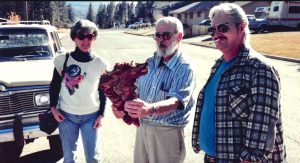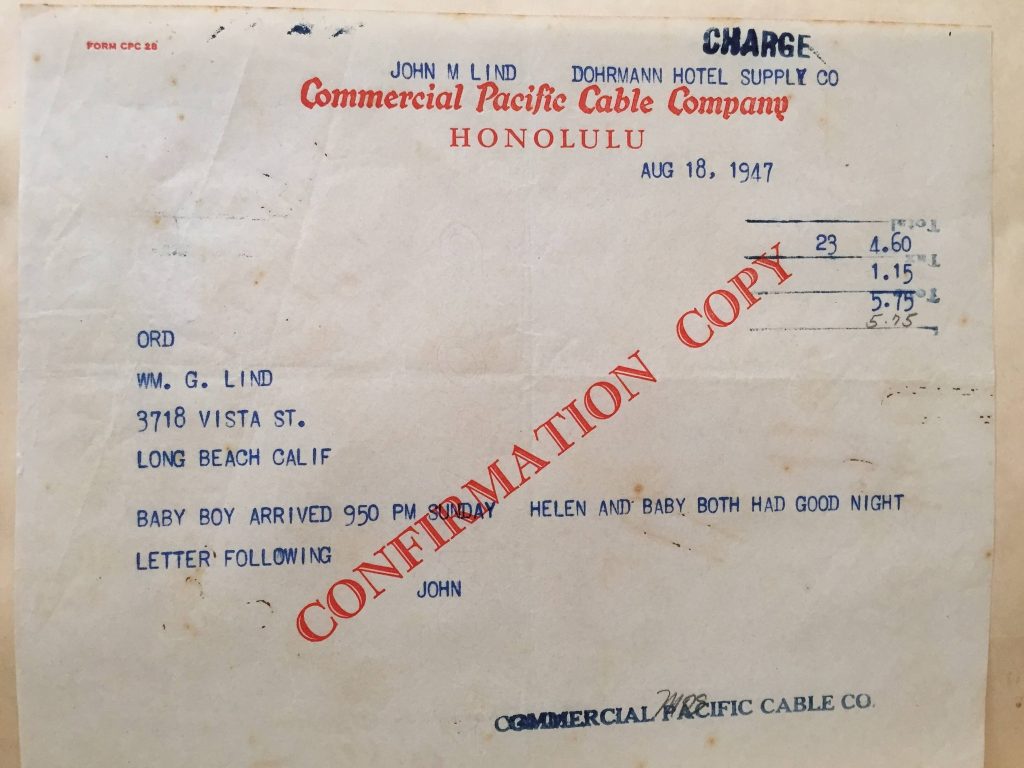In the months following the death of my mother, Helen Yonge Lind, in early 2013, just months before her 99th birthday, I found lots of interesting items in her jumbled collection of papers, including correspondence, typed or handwritten notes, photos, and miscellaneous newspaper clippings.
This is a slightly-edited version of an entry originally posted in November 2013. It describes time she spent living in Haleiwa as a girl.
She moved to Haleiwa with her father in 1922 after he took a job as a collector for Mutual Telephone Company, the predecessor of Hawaiian Telephone. My mother’s version of the story was that she was assigned to do housekeeping for her father.
Her older sister, Marguerite, stayed in Waipahu with their mother and their newborn brother.
They lived in Haleiwa for three years before her father was able to transfer back to a position in Waipahu, according to her notes.
Sometime after her 90th birthday in 2004, my mother sat down and typed out notes of what she recalled of that time.
For three years of my childhood in the 1920s, I lived in Haleiwa in the makai section close to the grand old Haleiwa Hotel and the Anahulu Bridge. Even at the tender age of 10, there was no mystery about the names. I understood perfectly that I lived in Haleiwa in the district of Waialua. The town that bore the name of the district Waialua was several miles distant surrounding the sugar mill and plantation housing. I doubt if that particular area was actually called Waialua before the advent of the plantation. When the plantations of Waialua, Waianae and Ewa were established, each was given the name of its district, not the Hawaiian place-name of the location.
Although located in Haleiwa, the Waialua District Court House and the Waialua Elementary School were so named because they served the entire district. That was the Waialua District court and the Waialua District school. Some of my school friends came every day from the banana farms of Kawaihapai and from Puuiki out beyond the Waialua mill. Next to the school, out on Kaiaka Point, was the Waialua Fresh Air Camp, now a state recreational area.
On the 1841 Wilkes map prepared by the U.S. Exploring expedition of 1838-1841, the various districts of Oahu are shown with Waialua extending across the entire North Shore.
Over the years some names of places have changed or new ones have been adopted. I don’t know when it happened, but Paumalu, the “beach of the sneaky waters,” disappeared and Sunset Beach entered the scene. Other place names well known years ago have been forgotten. Puuiki and Kawaihapi don’t even appear on current road maps.
It was many years ago, but I still recall a few of the names of people I knew in Haleiwa. My best friend and constant companion was Jenny Woodd, who became an entertainer and the grandmother of currently popular singer, Amy Hanaialii Gilliom. Jenny’s brother, Johnny Woodd, was a well known local swimmer in his day. There was John Kukea who chose the career of a fire fighter and a water sports enthusiast. One of his sons is connected with the Kamehameha Schools. Tommy Cleghorn sat behind me in the 5th grade and delighted in poking my back with sharpened pencils. He went on to Punahou and became an anthropologist with the Bishop Museum.
The Mahoe family lived on a rise beyond the Anahulu river. A granddaughter is Marie Adams McDonald, an artist and the author of the beautiful definitive book about the Hawaiian lei. Across the street from us was the Takahashi family. I don’t remember if they had a store, but I believe they were the owners of the community furo which I remember well. On a number of occasions, my sister and I donned our kimono, placed a bar of soap in our little bamboo baskets, grabbed a towel and trekked across the street to bathe and bask in the warm, soothing waters of the furo amongst people of all ages. The Laird family lived on the banks of the Anahulu near the old missionary Emerson house. Years later we met again when one of the daughters and I worked together in the same department at UH.
I wonder if many residents today are aware there was once a thriving glass bottom boat business owned and operated by a man named Jenkins. His boats that took paying customers out into the bay to view reef life were moored next to the bridge on the lowest slope of the hotel grounds. As far as I know, he was not married and left no descendants.
I have two outstanding memories of the area. One was a tidal wave around 1922-25. A couple ran up the street shouting, “the kai, the kai” (the sea, the sea) and people flocked to the beach. We stood on a high area above the sandy beach to watch. I have a mental picture of the water in the bay receding and then suddenly rising into a high wall of water pushing toward the shore. There weren’t any curling waves as portrayed in surfing films. The ocean seemed to just swell up and then move forward. Then someone hustled us inland so I did not see what happened next. Nor do I remember if there was any property damage.
Another vivid memory is one of ethereal beauty, the spectacular and captivating sight of the lotus ponds in full bloom. The scene was so impressive, it has remained with me through all the years.
Helen Y. Lind
Kahala









